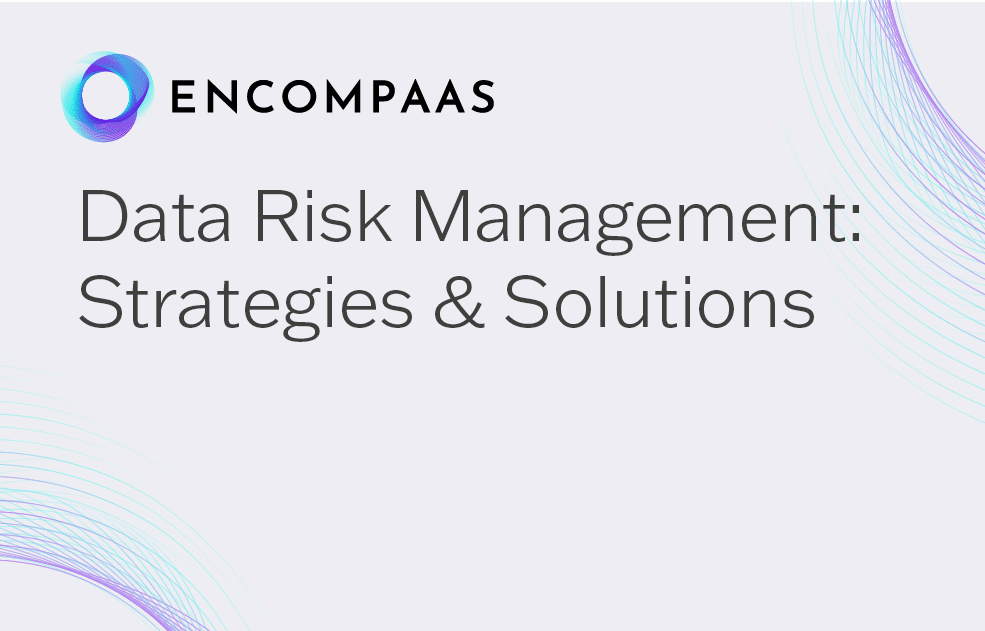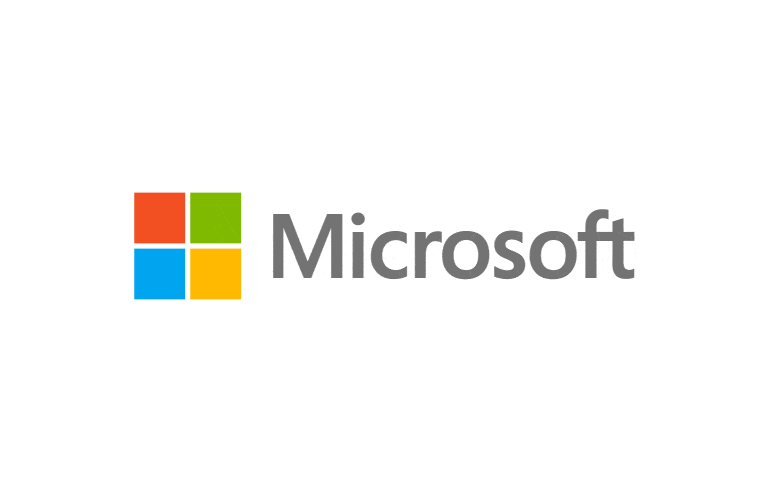Data Risk Management: Strategies & Solutions
Authored by EncompaaS - Jul 8, 2023
Share

As the digital world evolves, protecting your valuable digital assets becomes increasingly critical. This blog explores the complexities of data risk management, an indispensable tool in digital asset security. It underscores the importance of crucial strategies, timely solutions, and the importance of the integration of generative AI to mitigate the serious implications stemming from data breaches, non-compliance, and other digital threats.
Join us as we explore the details of data risk management and provide you with solutions and strategies for securing your data.
Main takeaways from this article:
- Data risk management is a critical practice for protecting digital assets against various threats, including data breaches and non-compliance.
- Effective data risk management necessitates a structured approach to identifying, assessing, and managing potential risks to data.
- Promoting an organizational culture that prioritizes data privacy and security is a powerful strategy for mitigating data-related risks.
- Advanced technologies such as AI, machine learning, and automation can significantly enhance data risk detection and security measures.
- EncompaaS, leveraging generative AI and robust data quality, presents a transformative approach to data risk management.
What is data risk management?
Data risk management is the incorporation of procedures, protocols, and systems to identify, assess, control, and minimize risks related to data. Bridging information technology and risk management domains, it safeguards digital assets, prevents data breaches or losses, ensures regulatory compliance, and enhances operational resilience within an organization.
Why is data risk management important?
Data risk management is critical for companies today for several reasons. Ignoring this aspect can lead to grave repercussions such as data breaches and poor data governance, which jeopardize the confidentiality and integrity of sensitive data, and compliance failures that can result in hefty fines and reputational damage.
Beyond these immediate threats, a data risk management plan plays an essential role in strategic decision-making, enabling organizations to anticipate and navigate potential pitfalls. It provides enterprises with operational resilience, empowering them to withstand and adapt to unforeseen circumstances in a volatile digital environment.
Key types of data risks
Understanding the different types of data risks is the first step in developing an effective risk management plan for data breaches and loss. Let’s dive deeper into these risks and their potential impact on businesses:
- Data breaches: These are incidents where unauthorized individuals access and possibly exploit your data. For instance, a data breach could expose customers’ data, leading not only to the erosion of trust among clients but also significant legal consequences.
- Data loss: This type of risk refers to the loss of data due to various reasons, such as accidental deletion, system malware, or even natural disasters. If data isn’t adequately backed up, data loss can cause significant disruptions to business operations and impair long-term planning.
- Compliance failures: Non-compliance to data governance rules and regulations can result in severe penalties, including heavy fines. For example, the failure to comply with GDPR rules can lead to fines of up to €20 million or 4% of the company’s global annual revenue, whichever is greater.
With these risks comes the responsibility to understand, mitigate, and occasionally navigate their consequences. And that’s where robust data risk management becomes indispensable.
Best practices for managing data risk
Let’s delve deeper into the primary means of dealing with data-related risks and data breaches: implementing practices that effectively help manage data risks and mitigate threats.
Establish a comprehensive data risk management framework
A comprehensive data risk management framework is key to mitigating potential threats and ensuring your business’s cyber resilience. Having a structured approach equips an organization with the necessary tools to identify, assess, and manage data-related risks effectively. Consider this:
- Identification: The first step towards managing data risk and security risks lies in being able to identify potential vulnerabilities within your system. This can include anything from weak points in your network security to employee error.
- Assessment: After identifying potential vulnerabilities, it’s crucial to assess the level of security risks they pose. Risk assessment will help you understand the potential damage a data breach may cause so you can prioritize your response strategies accordingly.
- Management: Based on your assessments, you can now create strategies to manage these security risks. This spans preventive measures, like implementing stronger data security protocols and response strategies for when a breach occurs.
- Monitoring: Continuous monitoring is crucial to ensure your measures remain effective and up to date. With the rapidly evolving digital landscape, new threats can emerge at any time, emphasizing the need for vigilant oversight.
Prioritize data classification and inventory
Managing data risks and data breaches begins with recognizing what you possess.
Here’s why:
- Identify critical information: Knowing what data your organization handles allows you to identify which information is crucial and sensitive. This differentiation is essential for effectively prioritizing the allocation of resources and security measures.
- Understand data sensitivity: Recognizing the sensitivity level of your data reveals the potential security risks and impacts of a data breach. It informs decisions about the extent of protections needed.
- Regulatory compliance: Classification supports compliance with various regulations that require specific controls for different types of data, such as personally identifiable information (PII) or health-related data. Complying with these laws reduces the risk of costly penalties and reputational damage.
- Guide access controls: Based on the sensitivity of the data, you can determine who in your organization should have access to it. This avoids unnecessary exposure and consequent potential breach.
- Informed decisions on storage and backup: Understanding the type and sensitivity of data guides decisions like where to store it, choosing the right encryption processes, and deciding which data requires frequent backup.
The classification and inventorying of data is a vital first step – laying the groundwork for successful risk mitigation and strategic decision-making in data administration.
Implement strong data security measures
Implementing concrete data security measures is an integral element of any robust data risk management framework. Here are some essential approaches to strengthen your security:
- Encryption: One of the most effective ways to protect your company from data breaches and security risks, both at rest and in transit, is encryption. It converts readable data into a coded form, which can only be deciphered using the correct decryption key. It reduces the likelihood of unauthorized access to your sensitive data.
- Access controls: Not all members of your organization need access to all data. Implement a system of permissions and controls to limit who can access what. Regular audits of these controls can flag any potential vulnerabilities due to overly broad permissions or inactive accounts.
- Secure data storage: Ensure that your data storage systems are both physically secure and protected against virtual intrusions. Regularly update and patch systems for known vulnerabilities and consider additional protections like firewalls and two-factor authentication.
Perform regular compliance checks and updates
Staying compliant with evolving data regulations is crucial for risk management, and it is a feat that is only possible through regular compliance checks and updates. However, this process is not mere paperwork. It requires significant efforts, including:
- Keeping abreast of regulatory changes: The general data protection regulation and laws around data security and privacy are continually evolving. Therefore, it is crucial to stay updated with changes and understand how they impact your business.
- Auditing data practices: Ensure the implementation of data rules by conducting regular, thorough audits of your data management practices and data risk assessment. This will also identify any gaps that may expose your organization to risks.
- Updating policies: With every regulatory change, it’s essential that you adjust your company’s policies accordingly. This might require training staff on new procedures or technology.
- Risk monitoring and reporting: Data risk governance requires vigilance. Regular monitoring and evaluation of the impact of your risk mitigation strategies are essential. Detailed reports that analyze current risk status and suggest improvements can be incredibly insightful.
- Flexibility: Your data governance program should be flexible enough to integrate changes as new standards and rules appear. This helps maintain compliance without disrupting your operations and helps in good data management.
- Engagement with business activities: Regular assessment of business engagement and evaluation of processing activities for any data risk ensures proper data management.
Promote a culture of data privacy and security awareness
Cultivating a culture focused on data privacy and security isn’t just an option – it’s a necessity for modern enterprises. Here’s how you can infuse these principles into your organization’s culture:
- Regular training: Conduct frequent workshops and training sessions to keep your team updated on the latest data privacy and security strategies. This ongoing attention demonstrates the importance of adhering to security protocols and handling sensitive data responsibly.
- Effective communication: Ensure that all levels of staff understand the policies and regulations surrounding data usage and handling. This knowledge ensures that everyone knows the role they play in securing your data assets.
- Employee empowerment: Develop an environment where employees feel responsible for the digital assets they interact with daily. Regular briefings, guidance on threat avoidance, and access to robust security tools can aid this.
- Management involvement: Involve leadership in promoting the importance of cybersecurity. When lessons about data protection come from the top, employees are likely to follow suit.
- Promotion of best practices: Encourage employees to practice good security habits, such as secure password management, regular data backups, and avoiding suspicious email links, to minimize risks.
Leverage advanced technologies for data protection
Today’s information age calls for technologically advanced solutions when dealing with data risk management. Harnessing the power of Artificial intelligence (AI), machine learning, and automation can radically transform, enhance, and secure your organization’s data. Here’s how:
- AI and machine learning: AI technologies, coupled with machine learning algorithms, help in identifying potential security threats that could put the organization’s data at risk. AI learns from previous incidents to predict and promptly react to suspicious activities. Furthermore, machine learning algorithms can be trained to identify patterns of data misuse, making the detection process much more efficient than manual methodologies. Embracing cutting-edge technology can enhance data quality, paving the way for unparalleled insights into Gen AI readiness.
- Automation: Implementing automated security systems can greatly reduce the possibility of human error, one of the most significant contributors to data breaches. Automation can streamline security protocols, ensuring they are consistently and rigorously applied, leaving no room for oversights that could compromise data.
- Continuous monitoring: AI and automation also enable continuous monitoring of your organization’s data ecosystem. This persistent monitoring establishes an additional layer of protection, flagging potential security breaches at their inception and preventing further escalation.
- Risk detection: Advanced technologies can analyze vast amounts of data swiftly, outperforming traditional detection methods. They highlight anomalies in real-time, enabling quicker responses to potential data risks and minimizing the impact on your business operations.
Enabling advanced technologies in your organization is not just a step toward modernization but a significant stride toward a more secure and controlled digital environment.
Continuous monitoring and response planning
In the evolving digital landscape, merely having data protection measures in place is not enough. What is equally crucial is the ongoing monitoring of these protective measures to ensure they remain effective and appropriate.
Recognizing potential risks early can be the difference between safeguarding your valuable data and facing a data breach. Here’s how you can monitor your data effectively:
- Consistent monitoring: Frequent checks of your data security processes can highlight areas for improvement and detect potential vulnerabilities. Regular monitoring can also help keep your organization compliant with changing regulatory requirements.
- Robust incident response plan: Despite all efforts for a secure data infrastructure, data breaches can still occur. In these moments, a well-defined incident response plan becomes vital. This plan should cover identifying the breach, containing the impact, eliminating the cause, implementing recovery measures, and conducting an after-action review.
- Data breach simulations: Conduct regular data breach simulations to ensure your incident response mechanism works under pressure. This helps prepare your staff for a real-world situation and can highlight areas in your response plan that might need further development.
By combining consistent security monitoring with solid response plans, you enhance your ability to manage data risks effectively and reduce potential harm should a data breach occur.
Secure your data with EncompaaS
As we’ve explored, effective data risk management is pivotal to securing digital assets, reducing data breaches, and maintaining compliance. Implementing a comprehensive framework, prioritizing data classification, promoting security awareness, leveraging advanced technologies, and performing regular checks are all great practices.
However, with advanced data compliance and privacy solutions, EncompaaS revolutionizes the way organizations manage their data risks.
We encourage you to explore how EncompaaS can fortify your data risk management strategy and prepare your organization for the evolving demands of digital security.
Book a demo
Let's get started
Experience the Power of EncompaaS!
Submit this form to see EncompaaS in action with a demo from our information management experts.
Related Resources

- Blog

- Blog
Breaking down data silos: Unlocking generative AI at scale
Generative AI (GenAI) is rapidly moving from pilot projects to production environments. Across industries, CIOs and Chief Data Officers are under pressure to translate early…
- Artificial Intelligence
- Content Intelligence
- Data Preparation
- Information Management
- Intelligent Document Processing
Learn More



